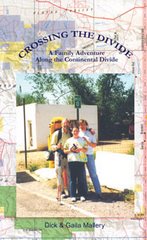1997 the route through Rocky Mountain National Park was adjusted and now consists of approximately 30 miles of spectacular scenery. In the park, the Continental Divide National Scenic Trail route does not entirely travel the actual Divide, however the most breathtaking section is above treeline, consisting of high peaks and fragile alpine tundra. Travel is through the montane and sub-alpine life systems at elevations of 8,000 (2,438 m) to 11,500 feet (3,505 m).In north to south direction, the route enters the park on County Road 491. It then follows the River Trail north until it intersects with Trail Ridge Road (Highway 34) Near Green Mountain Trailhead. At this point the route follows the Green Mountain Trail east to the Tonahutu Creek Trail where it heads north and east to the junction of the North Inlet Trail. Here the route touches the actual continental divide at an elevation of 12,324. The North Inlet Trail is followed south and west to the town of Grand Lake. Once through Grand Lake, the route heads south along the East Shore Trail and exits the park at the south boundary. The route is entirely along existing, well-maintained trails.Should you decide to travel the Continental Divide National Scenic Trail through the park for a few hours or several days, here are a few considerations:
The air is thin at these high altitudes between 10,500 feet (3,200 km) and 13,000 feet (3,962 km). Travel is slow and strenuous.
Lightning danger accompanies early afternoon thunderstorms. Travel above treeline should be accomplished early in the day.
Winter lasts about nine months on the Divide, from September through May. Arctic conditions prevail making travel extremely hazardous, if not impossible, during this season.
Always practice Leave No Trace hiking and camping skills.
Camping Permits:A backcountry permit is required in Rocky Mountain National Park for any overnight trips. The permits can be obtained by writing to Rocky Mountain National Park, Backcountry Office, Estes Park, Colorado 80517-8397 or call 970.586.1242.Water and Fire:Water sources are from lakes and streams and should be treated or boiled before drinking. Self-contained stoves are required at most backcountry campsites. Wood fires are allowed only at a few specific designated campsites. Where permitted, all campfires must be in metal grates provided.Pets:Pets are prohibited on all trails and in backcountry areas of Rocky Mountain National Park. If you bring a pet on the Continental Divide National Scenic Trail, an alternate route to bypass the park (north to south) is to travel along County Road 491 and U.S. Highway 34 past Grand Lake to the Arapaho Bay Road rejoining the actual route south of the park. Pets are allowed along park roads and must be on a leash and under physical control at all times.Fishing and Hunting:Fishing in Rocky Mountain National Park requires a license from the State of Colorado. Specific park regulations list open and closed waters. Fish populations in high elevation lakes and streams are spotty. The park does not stock, except to reintroduce native species. Hunting is prohibited in Rocky Mountain National Park. Firearms or any projectile weapons are prohibited in the park.
The air is thin at these high altitudes between 10,500 feet (3,200 km) and 13,000 feet (3,962 km). Travel is slow and strenuous.
Lightning danger accompanies early afternoon thunderstorms. Travel above treeline should be accomplished early in the day.
Winter lasts about nine months on the Divide, from September through May. Arctic conditions prevail making travel extremely hazardous, if not impossible, during this season.
Always practice Leave No Trace hiking and camping skills.
Camping Permits:A backcountry permit is required in Rocky Mountain National Park for any overnight trips. The permits can be obtained by writing to Rocky Mountain National Park, Backcountry Office, Estes Park, Colorado 80517-8397 or call 970.586.1242.Water and Fire:Water sources are from lakes and streams and should be treated or boiled before drinking. Self-contained stoves are required at most backcountry campsites. Wood fires are allowed only at a few specific designated campsites. Where permitted, all campfires must be in metal grates provided.Pets:Pets are prohibited on all trails and in backcountry areas of Rocky Mountain National Park. If you bring a pet on the Continental Divide National Scenic Trail, an alternate route to bypass the park (north to south) is to travel along County Road 491 and U.S. Highway 34 past Grand Lake to the Arapaho Bay Road rejoining the actual route south of the park. Pets are allowed along park roads and must be on a leash and under physical control at all times.Fishing and Hunting:Fishing in Rocky Mountain National Park requires a license from the State of Colorado. Specific park regulations list open and closed waters. Fish populations in high elevation lakes and streams are spotty. The park does not stock, except to reintroduce native species. Hunting is prohibited in Rocky Mountain National Park. Firearms or any projectile weapons are prohibited in the park.












No comments:
Post a Comment